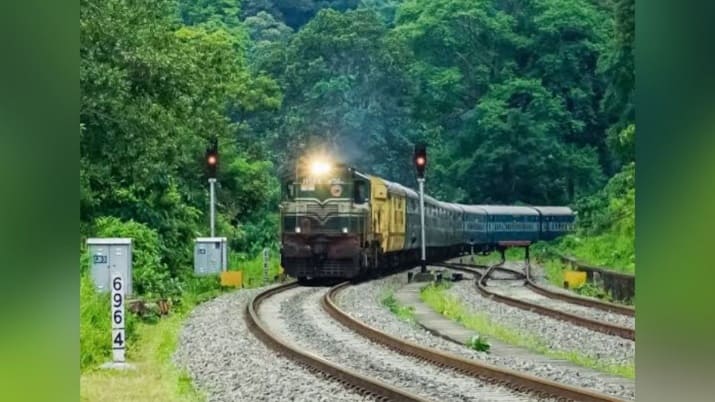Description


Disclaimer: Copyright infringement not intended.
Context
- Ministry of Railways has formulated a new policy for modernization of stations named “Amrit Bharat Station” scheme.
Details
- Amrit Bharat Station scheme envisages development of stations on a continuous basis with a long-term vision.
- It is based on Master Planning for long term and implementation of the elements of Master Plan as per the needs and patronage of the station.
Broad objectives
- The scheme aims at preparation of Master Plans of the Railway stations and implementation of the Master Plan in phases to enhance the facilities including and beyond the Minimum Essential Amenities (MEA) and aiming for creation of Roof Plazas and city centres at the station in long run.
- The scheme shall aim to meet the needs of the stakeholders, station usage studies as far as possible based on availability of funds and inter-se priority.
- The scheme shall cater for introduction of new amenities as well as upgradation and replacement of existing amenities.
- This scheme will also cover the stations where detailed techno-economic feasibility studies have been conducted or are being conducted but the work for construction of Roof Plazas has not been taken up yet, ensuring the phasing of Master Plan being suitably implemented and relocation of structures and utilities being given more emphasis in the phasing plans.
.jpg)
Scope of Work
To meet the above objectives, following broad scope of work is envisaged for stations selected under the Amrit Bharat Station scheme:
- The Master Plans to have elementary details of the most appropriate location of Roof Plaza to be created in future.
- The scheme envisages cost efficient improvement to facades, provision of wide, well lit aesthetically pleasing entrance porches.
- Existing building usage shall be reviewed and space should be released in favour of passengers near the station entrances and the Railway offices should be suitably relocated.
- The scheme aims to relocate redundant/old buildings in a cost-efficient manner so that space is released for higher priority passenger related activities and future development may be carried out smoothly. Creation of new buildings should generally be avoided other than those required for relocation of old structures or relocation of structures to improve circulation or provision of structures to improve the size of waiting halls.
- Attempts shall be made to club different grades/types of waiting halls and provide good cafeteria/retail facilities as far as possible. Suitable low-level partitions may be done in waiting halls.
- Provision for minimum two stalls for One Station One Product shall be made.
- Space shall also be created for Executive Lounges and places for small business meetings.
- At least one aesthetically designed hoarding(signage) on each side of the circulating area at a prominent location shall be erected for display of important information etc. The size of such hoarding shall not be less than 10mx20m.
- Station approaches would be improved to ensure smooth access by widening of roads, removal of unwanted structures, properly designed signages, dedicated pedestrian pathways, well-planned parking areas, improved lighting etc. Necessary liaison should be established with local authorities for necessary improvements to be carried out by local authorities in their areas.
- Elements of landscaping, green patches and local art and culture should be used to create a pleasant experience for the station users. This should be done with the help of suitable professionals.
- Second Entry Station Building and circulating area shall be improved as per the needs of the station. Wherever second entry building is not being provided presently, space for circulating area will be well planned and a liaison shall be established with the local bodies so that approach roads for second entry are kept in the city’s Master Plan and development around the station is suitably controlled.
- High level platforms (760-840 mm) shall be provided at all categories of stations. Length of the platforms shall generally be 600m.
- Length, location and phasing of Platform shelters shall be decided based on usage of the station.
- Ballastless tracks would be provided on platform lines and lines with train maintenance facilities.

|
BALLASTLESS TRACK
A ballastless track or slab track is a type of railway track infrastructure in which the traditional elastic combination of ties/sleepers and ballast is replaced by a rigid construction of concrete or asphalt. In ballastless tracks, the rails are rigidly fastened to special types of concrete ties/sleepers that are themselves set in concrete. Ballastless tracks therefore offer a high consistency in track geometry, the adjusting of which is not possible after the concreting of the superstructure. Therefore, ballastless tracks must be concreted within a tolerance of 0.5 millimetres (0.0197 in). The elasticity of the ballast in the traditional railway superstructure is replaced by flexibility between either the rails and the concrete ties/sleepers or the ties/sleepers and the concrete or asphalt slab as well inherent elasticity within the conglomerate of the tie/sleeper, whereas the concrete or asphalt slab is usually inelastic.
|
- Drainage of platform areas is of utmost importance. Special emphasis shall be given to achieve self-cleansing of drains as far as possible. Suitable cross drains, sump and pump arrangement may be provided where natural slopes are not adequate. Drains may be covered with aesthetically designed theft resistant covers.
- Cables should be covered in aesthetically designed duct and should have provision for future cables as well.
- The Master Plan shall mark the space for Parcel handling spurs, storage and handling facilities Works should also be proposed and executed in suitable phases.
- Provisions may be made such that as far as possible the station provides free WiFi access to its users. The Master Plan should have suitable spaces earmarked for 5G towers.
- Material finishes of elements, such as flooring, walls, structures, furniture, sanitary fittings, etc. within the public areas of the station where surfaces either come in direct physical contact of passengers or are visible to them should be highly durable (preferably washable), generally dustproof and need low maintenance.
- The furniture available on Waiting halls, Platforms, Retiring Rooms, Offices shall be reviewed and intervention planned for more comfortable and durable furniture suitable to the Railway Stations of that area. In a phased manner, it shall be planned to eliminate multi-design furniture.
- Signages should be well designed for intuitive way finding, should have good visibility and be aesthetically pleasing. Quality of public announcement systems should be improved.
- Escalators may be provided at stations irrespective of footfall.
- Amenities for Divyangjan at stations shall be as per guidelines issued by Railway Board from time to time.
- Ceremonial flags may be provided at appropriate space in the station.
- At least two station name boards should be LED based with good visibility for the passengers of trains passing through the station.
- Circulating area boundary wall normally should not block the view of the station from outside. Access may be controlled by iron/steel grill fencing.
- Sufficient number of toilets shall be provided at all categories of stations with separate provisions for women and Divyangjan. Location of toilets should be appropriate to station usage, easily visible and accessible.
- Gradual shift to sustainable and environmental friendly solutions as per availability of funds and condition of existing assets.
https://pib.gov.in/PressReleasePage.aspx?PRID=1886884














